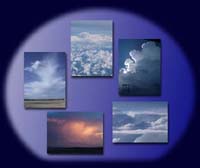Dust and Haze |
|
| Hazy Atmosphere | |
| Urban Air Pollution | |
| Smog at Crete | |
| Inversions | |
| Dust Devil | |
| Sahara Dust | |
| Seasalt Aerosol | |
| Overview | |
Urban Pollution - Brown Clouds and Smog
|
|
Sao Paulo, Brazil
Teheran, Iran
Esfahan, Iran
|
The phenomenon of "Brown clouds" - also called smog dome or smog - is a consequence of urban air pollution. Nitrogen oxides, organic gases, and aerosol particles are released together with several other gases within the emissions from traffic, industry and the combustion of fossil fuels. Under conditions of strong solar radiation photochemical processes will occur in the air. They lead to the formation of aerosol particles directly from the gaseous state - the so-called homogenous nucleation. The released and freshly generated aerosols blur the air and reduce the visibility in the atmosphere. Nitrogen dioxide (NO2) is built from nitrogen monoxide (NO) via oxidation. The brown colour results from the absorption spectrum of the nitrogen dioxide. It absorbs the blue and the short green wavelengths of the visible light, but permits the longer wavelengths of the green and the red light to pass. This results in the brown colouring. BrownCloud1.jpg: The "Brown cloud" is formed at the dent
in front of the mountain. Between 7 a.m. and 10 a.m. it has grown
so much that the mountain was not visible anymore. The image was
taken from the 20th floor of the "Hilton Colon" Hotel
in Quito. The summer smog in Teheran, Iran:
Teheran is located 1300 m above sea level. It has approximately
14 million residents and 2 million cars. The cars do not have catalytic
converters and neither cars nor trucks are equipped with diesel
soot filters. The sulphur content is not limited in the fuel. (Since
January 2005 the sulphur content in petrol and diesel has to be
lower than 10 ppm(m) in the EU). In combination with the strong
solar radiation it is not surprising that at each day intense photochemical
smog arises in Teheran. It ranks among one of the worst in the world.
The traffic is incredibly crowded and resembles the kinetic gas
theory from the mathematical point of view. The north of Teheran
is an amazing "green" city because of several avenues
and parks. The observer can clearly see this from a viewpoint in
the mountains. The topography plays an important role for the boundary
layer of the atmosphere, because Teheran is enclosed in the mountain
chain of the Alborz Rocks. The first mountain chain already has
an altitude of 3000 m. The tourist place Touchal with view to Teheran
is located at an elevation of 3800 m and the Damavand reaches up
to 5000 m. In chapter "Cumulus" - paragraph "Status
nasc. Smog BL top" - the consequences of the dispersion of
the smog are described in detail. |
BrownCloud28+29.jpg were taken from the building site of the Milad Tower which is located in the north-east of Teheran. The view is directed to the south. In the morning the brown smog layer can be especially clearly noticed. Tower1-3.jpg: These pictures show the tower under construction.
Finally it will reach an altitude of 350 m and resist earthquakes
of magnitude 7 on the Richter scale. The building has already an
altitude of 280 m at the picture. The tower is used for telecommunications
as well as for measurements of the atmospheric boundary layer over
Teheran. BrownCloud30.jpg: This picture was taken from the Geophysical Institute in the north of Teheran with a view to the south in the early morning. TouchalPanorama.jpg: At the northern end of Teheran one can take the cable car to go from 1300 m to 3800 m a.m.s.l. The cable car is divided into two parts and has a total length of 8 km. The town Touchal is located at the end of the first part. The panorama picture was recorded next to a SINOP meteorological station at an altitude of 3800 m. At the left hand side is south-east, at the right side south-west and the view is directed over Teheran. The inversion above the smog layer is here at least at a level of 3000 m. Cloud images from the upper limit of the inversion as well as another panorama picture could be found under "Status nascendi, Smog BL Top" in chapter "Cumulus". Smog1-3.jpg (Esfahan): Esfahan is
located 330 km south of Teheran in an arid region at around 1500
m a.m.s.l. Also here one has to be concerned about anthropogenic
air pollution, but it is less severe compared to Teheran. This pollution
arises from traffic and domestic emissions in the winter as well
as from industrial emissions (steel production and one refinery)
predominantly in the east of the city. Although the city is embedded in a desert landscape, it is quite "green" as shown by the images. The abundant fine mineral dust stemming from the desert nearby is a special component of the air pollution. It is still unknown how the dust from the desert interacts with the components of the anthropogenic air pollution. See also the chapter Dust Devil.
|
Germany
|
![]()

_TN.jpg)
_TN.jpg)
_TN.jpg)
_TN.jpg)
_TN.jpg)
_TN.jpg)
_TN.jpg)


_TN.jpg)
_TN.jpg)
_TN.jpg)
_TN.jpg)
_TN.jpg)
_TN.jpg)
_TN.jpg)
_TN.jpg)
_TN.jpg)
_TN.jpg)
_TN.jpg)
_TN.jpg)
_TN.jpg)
_TN.jpg)
_TN.jpg)
_TN.jpg)
_TN.jpg)
_TN.jpg)
_TN.jpg)
_TN.jpg)
_TN.jpg)
_TN.jpg)
_TN.jpg)
_TN.jpg)
_TN.jpg)
_TN.jpg)

_TN.jpg)
_TN.jpg)
_TN.jpg)
_TN.jpg)
_TN.jpg)